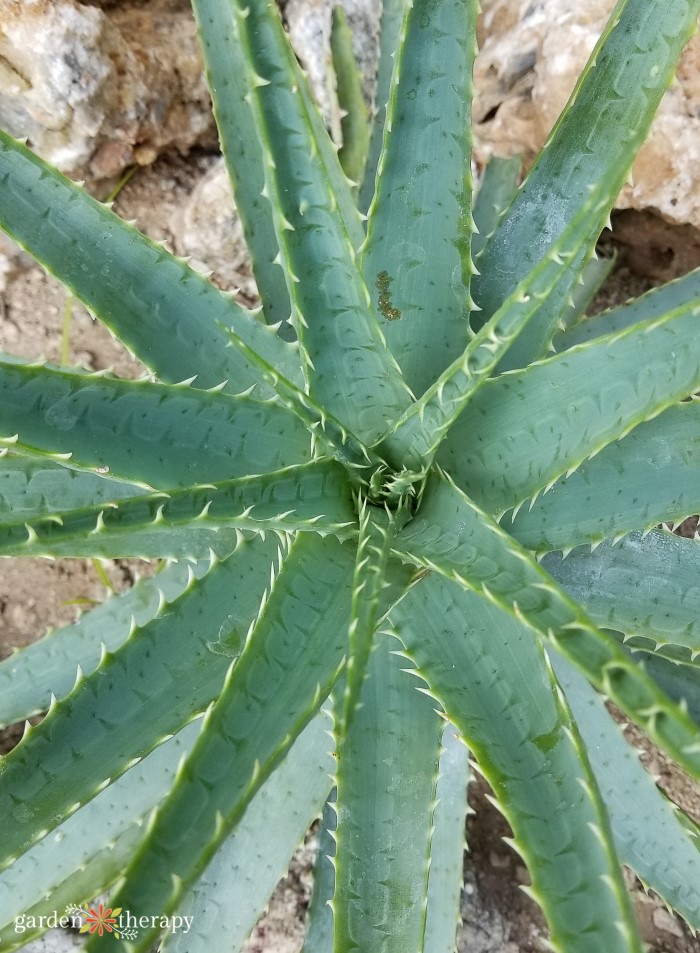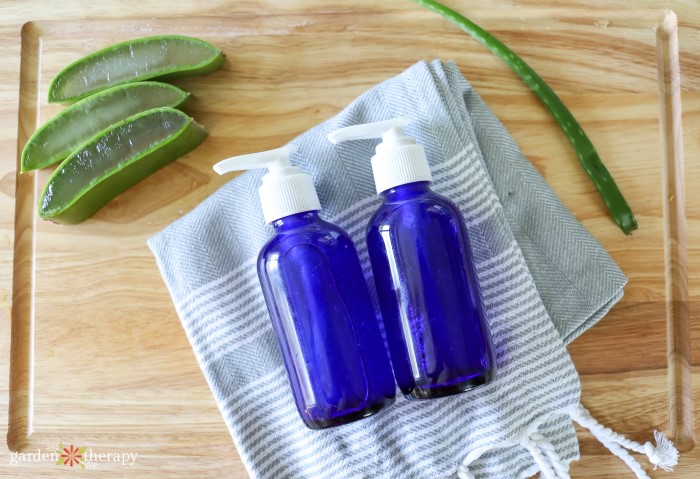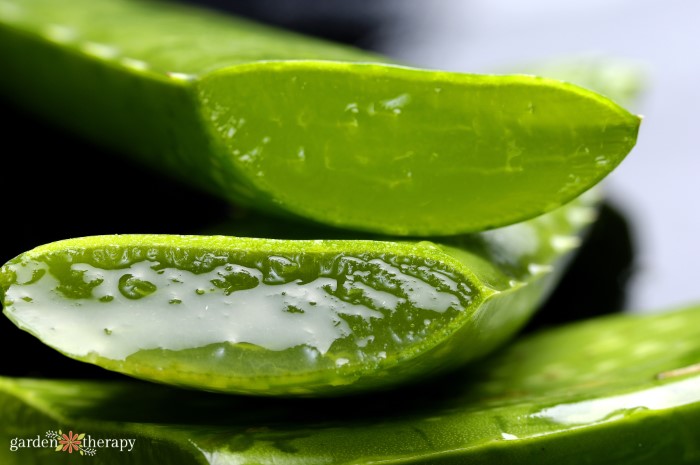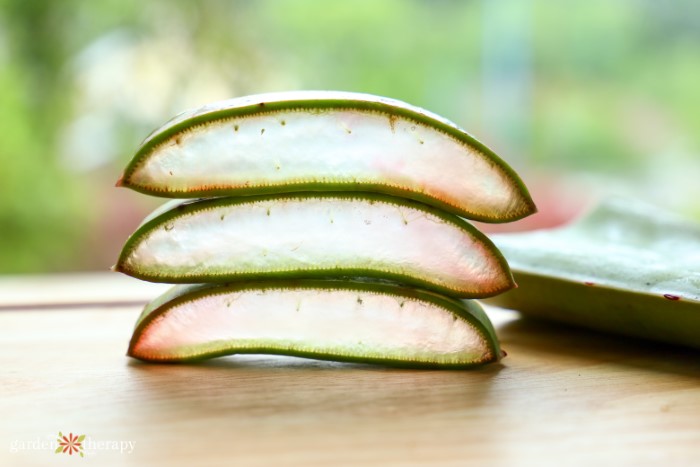Aloe vera is one of those true super plants. It is perhaps most revered for its ability to soothe the pain of sunburn. While this is certainly one of its uses, aloe vera can do so much more. Read on to learn how to use aloe vera for sunburn, other aloe vera benefits, AND how to care for an aloe vera plant.

When I was a little girl (a freckled, red-haired kid), I vividly remember visiting my grandmother’s house at the beach. She lived in a warm city where the sun shone constantly in the summer although there was enough wind to keep us cool.
This means more hours of fun in the sun, more than my skin can handle.. Even if I apply sunscreen and reapply it frequently, by the end of the day the sun still wins. I’m left with rosy shoulders that radiate heat all the way up to my ears!


That’s when my grandmother, the great grandmother, cut a small branch of aloe vera, sliced it open with a knife, and applied it to my shoulder. It stung a little at first, but then it soothed the sunburn. The relief was almost immediate, and when I woke up the next morning, my shoulder was pink but not inflamed and not as hot as the sun.
That is because Aloe vera is a powerful anti-inflammatory and is most effective when applied directly from the plant. Since then, I have always kept at least one aloe vera plant in my home and several have grown and provided me with healing gel for years.
Here’s what we’ll be covering today…


A Brief History of Aloe Vera
Vera (Aloe Barbadensis) To be one of the oldest plants recorded to have medicinal properties. This plant is native to eastern and southern Africa—even Cleopatra and Nefertiti used it to help maintain their youthful looks. Because of its highly adaptable nature, it has been cultivated all over the world.


Aloe Vera Care: How to Grow Aloe Vera
Vera, a succulent plant with thick, gray-green leaves with serrated marginsvery easy to grow. Just treat it like any other indoor succulent or cactus, except it is more adaptable to low light conditions.
To keep your aloe vera plant healthy, Plant it in well-drained soil. Equal parts potting soil and sand are best. The plant likes tight spaces and has shallow roots, so plant it in a pot large enough to not tip over under its weight.
Aloe vera likes bright, indirect light. Leaving the plant in constant direct light can cause the leaves to dry out too much and turn yellow.
As for water, aloe vera plants like to be watered thoroughly every few weeks and make sure the soil dries out completely between waterings.
If you tend to keep the soil moist and start to notice brown or limp leaves, your aloe vera may have root rot. Simply reduce the watering a bit and let the soil dry out before watering again.
Check out this article for complete and detailed instructions on how to care for aloe vera.


Benefits and Side Effects of Aloe Vera
In addition to it soothing, anti-inflammatory propertiesAloe vera is also used as a powerful laxative. However, as a laxative, it can also Aloe vera can cause stomach upset and intestinal discomfort if you take too much, so use with caution.
Additional benefits of using aloe vera include:
- Support for indigestion
- Reduce inflammation
- Prevent and reduce kidney stone size
Additionally, aloe vera can be used to help soothe sunburn, wounds, frostbite, dermatitis, skin disorders, and radiation burns.


Different uses of aloe vera
Aloe vera is truly an amazing plant! Here are some effective ways to use it.
- Relieves pain from sunburn. Perhaps the most well-known use for aloe vera, this plant helps cool the skin and speed up the healing process. It can also help reverse sunburn blisters if used before they develop. Read on to learn more.
- Relieves itching from insect bites. The plant’s anti-inflammatory properties help soothe sunburn and the itching, swelling and redness caused by insect bites.


- Helps clean and speed up wound healing. Aloe vera has antibacterial and antiseptic properties that help clean cuts and wounds by killing bacteria and fungi. Aloe vera also helps wounds heal faster.
- Cleanse and moisturize skin. Aloe vera’s pH is similar to our skin’s, which helps gently (but thoroughly) cleanse our faces while tightening pores and toning the skin. Its anti-inflammatory properties can also help prevent breakouts. Try it in this homemade liquid hand soap.
- Helps reduce wrinkles, stretch marks and scars. Aloe vera was known as the “plant of immortality” by the ancient Egyptians and helps promote the repair and healing of skin tissue.
How to use aloe vera to treat sunburn
The healing power of plants is undeniable, especially when something as simple as aloe vera can bring such great relief to such a painful thing: sunburned skin. A classic use for aloe vera (and perhaps one of the most popular aloe vera benefits), this sunburn remedy is one that I have been using for as many years as I can remember.
Using aloe vera gel to treat sunburn is very simple.
Using a sharp knife, cut a piece of aloe vera off the plant. Cut the top of one of the leaves; it can be as large as the entire leaf or as small as just a part of the leaf tip.
Place the cut piece on a paper towel and Let stand for 10 minutes to let the dark yellow latex flow out.. After 10 minutes, you can wipe the sides of the cut to remove the latex from the inside of the fillet. Latex can stain skin and clothing and may cause skin reactions in sensitive people.


Pro Tip: If you cut a section of the leaf at an angle (and not the whole leaf), the end of the leaf will stick to the latex (which is what it’s for!) and you can continue cutting the leaf another time.
Next, use a paring knife to cut the leaf in half so that the gel inside has the largest surface area. Take the leaf and rub it directly on the burn.
Note: Be sure to test a small area of skin before applying it all over. Some people are allergic to aloe vera straight from the plant and you don’t want to cause a worse reaction!
Careful: Do not use aloe vera on deep wounds.
You can also refrigerate the leaves and use them as a cold gel to soothe burns.. It will feel nice but doesn’t add any healing properties so this isn’t a necessary step.
Apply the leaves after you have applied the gel to your skin and repeat every six hours if you still want to relieve the discomfort of sunburn. Please note that this is a normal sunburn. Severe burns accompanied by blistering, headache or severe pain should be examined by a doctor.


Prevent sunburn
Luckily, now that I’m older and wiser, I don’t get sunburned anymore. Not because my skin has changed, but because I know these secret tips to keep my skin healthy:
- Keep away from sunlight from 11:00 am to 3:00 pm on hot days
- Wear long-sleeved, wide-brimmed clothing Sun hat
- Always wear sunscreen on exposed skin (even on cloudy days)
For more tips on sun safety, check out this article where I’ll tell you all the tips and tricks you need to know.


Frequently Asked Questions About Using Aloe Vera
The yellow liquid that oozes from aloe vera is the plant’s latex. It can cause a reaction in people with sensitive skin, and can also stain your skin and clothing. Before applying aloe vera to your skin, you should leave the cut end of the aloe vera on a paper towel for ten minutes to allow the yellow latex to drain.
Aloe vera is great for the skin, helping to heal burns and wounds, clear up acne, moisturize the skin, etc. It can also help reduce the appearance of scars and wrinkles, which can be a side effect of too much sun exposure.
While there are many aloe vera plants, aloe vera refers to Aloe Barbadensis plant. If you don’t have an aloe vera plant and are looking for a gel to apply to your skin, look for pure aloe vera gel (I generally stay away from that dyed green gel).
I hope that this information about aloe vera and my guide to using aloe vera for sunburn will help you as much as it has helped me through my years of sunburns. Now that you know some of the benefits of aloe vera, I hope you will try growing your own plant (it is great for both green thumbs and black thumbs!).
More summer recipes from the garden

